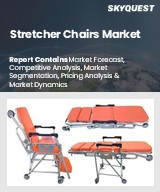
|
시장보고서
상품코드
1770768
스트레처 체어 시장 규모, 점유율, 성장 분석 : 제품 유형별, 작동 기술별, 최종사용자별, 유통 채널별, 지역별 - 산업 예측(2025-2032년)Stretcher Chairs Market Size, Share, and Growth Analysis, By Product Type, By Actuation Technology, By End User, By Distribution Channel, By Region - Industry Forecast 2025-2032 |
||||||
스트레처 체어 세계 시장 규모는 2023년에 2억 6,530만 달러로 평가되었으며, 예측 기간(2025-2032년) 동안 CAGR 4.6%로, 2024년 2억 7,750만 달러에서 2032년에는 3억 9,767만 달러로 성장할 전망입니다.
스트레처 체어 시장은 인구 고령화와 만성질환의 증가로 인해 꾸준히 성장하고 있습니다. 특히 북미와 유럽과 같이 의료비 지출이 증가하는 지역에서는 환자의 이동이 중요해지면서 의료 시설에서 인체공학적 기능이 강화된 첨단 들것을 선택하게 되었습니다. 전동식 포지셔닝, 항균 코팅, IoT 연결과 같은 기술 발전은 응급실, 수술실, 외래 등 다양한 환경에서 환자 치료를 개선할 수 있는 많은 기회를 창출하고 있습니다. 그러나 이러한 성장에도 불구하고, 여전히 과제도 남아있습니다. 특히, 예산의 제약으로 인해 소규모 시설에서는 많은 선행 투자가 필요한 최신 전기 모델을 채택하는 데 어려움을 겪고 있습니다. 또한, 유지보수의 복잡성과 숙련된 인력의 필요성은 이러한 혁신적인 모델의 보급을 가로막는 장벽이 되고 있습니다.
목차
소개
- 조사 목적
- 조사 범위
- 정의
조사 방법
- 정보 조달
- 2차와 1차 데이터 방법
- 시장 규모 예측
- 시장 가정과 제한
주요 요약
- 세계 시장 전망
- 공급과 수요 동향 분석
- 부문별 기회 분석
시장 역학과 전망
- 시장 개요
- 시장 규모
- 시장 역학
- 성장 촉진요인과 기회
- 성장 억제요인과 과제
- Porters 분석
주요 시장 인사이트
- 핵심성공요인
- 경쟁 정도
- 주요 투자 기회
- 시장 생태계
- 시장 매력 지수(2024년)
- PESTEL 분석
- 거시경제 지표
- 밸류체인 분석
- 가격 분석
- 사례 연구
- 고객 구매 행동 분석
스트레처 체어 시장 규모 : 제품 유형별 & CAGR(2025-2032년)
- 시장 개요
- 파워드 스트레처 체어
- 수동 스트레처 체어
- 기타
스트레처 체어 시장 규모 : 작동 기술별 & CAGR(2025-2032년)
- 시장 개요
- 전기 모터
- 유압식
- 공기압
- 기계식
스트레처 체어 시장 규모 : 최종사용자별 & CAGR(2025-2032년)
- 시장 개요
- 병원
- 외래 수술 센터
- 전문 클리닉
- 재택 케어 환경
- 기타
스트레처 체어 시장 규모 : 유통 채널별 & CAGR(2025-2032년)
- 시장 개요
- 기관투자가용 직접 판매
- 의료용품 판매업체
- 온라인/E-Commerce
스트레처 체어 시장 규모 : 지역별 & CAGR(2025-2032년)
- 북미
- 미국
- 캐나다
- 유럽
- 독일
- 스페인
- 프랑스
- 영국
- 이탈리아
- 기타 유럽
- 아시아태평양
- 중국
- 인도
- 일본
- 한국
- 기타 아시아태평양
- 라틴아메리카
- 브라질
- 기타 라틴아메리카
- 중동 및 아프리카
- GCC 국가
- 남아프리카공화국
- 기타 중동 및 아프리카
경쟁 정보
- 상위 5개사의 비교
- 주요 기업의 시장 포지셔닝(2024년)
- 주요 시장 기업이 채용한 전략
- 최근의 시장 동향
- 기업의 시장 점유율 분석(2024년)
- 주요 기업 개요
- 기업 상세
- 제품 포트폴리오 분석
- 기업 부문별 점유율 분석
- 매출 전년비 비교(2022-2024년)
주요 기업 개요
- Stryker Corporation
- GF Health Products, Inc.
- Wy'East Medical
- Productos Metalicos del Bages(Promeba)
- NovyMed International
- UFSK-International OSYS
- LINET Group SE
- Invacare Corporation
- Ferno-Washington
- TransMotion Medical
- Midmark Corporation
결론과 제안
ksm 25.07.21Global Stretcher Chairs Market size was valued at USD 265.3 million in 2023 and is poised to grow from USD 277.5 million in 2024 to USD 397.67 million by 2032, growing at a CAGR of 4.6% during the forecast period (2025-2032).
The stretcher chairs market is witnessing steady growth, driven by an aging population and rising chronic disease prevalence. With an increased focus on patient mobility, healthcare facilities are opting for advanced stretchers that enhance ergonomic features, particularly in regions with rising healthcare expenditures like North America and Europe. Technological advancements, including powered positioning, antimicrobial coatings, and IoT connectivity, are creating numerous opportunities, enabling improved patient care across emergency, surgical, and outpatient settings. However, despite this growth, challenges remain, particularly budget constraints that hinder smaller facilities from adopting modern electric models which require significant upfront investment. Additionally, the complexity of maintenance and the need for trained personnel pose further barriers to the widespread adoption of these innovative stretcher chairs.
Top-down and bottom-up approaches were used to estimate and validate the size of the Global Stretcher Chairs market and to estimate the size of various other dependent submarkets. The research methodology used to estimate the market size includes the following details: The key players in the market were identified through secondary research, and their market shares in the respective regions were determined through primary and secondary research. This entire procedure includes the study of the annual and financial reports of the top market players and extensive interviews for key insights from industry leaders such as CEOs, VPs, directors, and marketing executives. All percentage shares split, and breakdowns were determined using secondary sources and verified through Primary sources. All possible parameters that affect the markets covered in this research study have been accounted for, viewed in extensive detail, verified through primary research, and analyzed to get the final quantitative and qualitative data.
Global Stretcher Chairs Market Segments Analysis
Global Stretcher Chairs Market is segmented by Product Type, Actuation Technology, End User, Distribution Channel and region. Based on Product Type, the market is segmented into Powered Stretcher Chairs, Manual Stretcher Chairs and Others. Based on Actuation Technology, the market is segmented into Electric Motor, Hydraulic, Pneumatic and Mechanical. Based on End User, the market is segmented into Hospitals, Ambulatory Surgical Centers, Specialty Clinics, Home-Care Settings and Others. Based on Distribution Channel, the market is segmented into Direct Institutional Sales, Medical Supply Distributors and Online / E-commerce. Based on region, the market is segmented into North America, Europe, Asia Pacific, Latin America and Middle East & Africa.
Driver of the Global Stretcher Chairs Market
The global market for stretcher chairs is experiencing robust growth, primarily fueled by the increasing elderly population and a rising incidence of chronic health issues such as arthritis and cardiovascular diseases. This demographic shift has led to a higher demand for medical care, including the need for transportation within healthcare facilities. As hospitals and clinics strive to enhance patient satisfaction through improved comfort and safety, there is a growing investment in ergonomic and multifunctional stretcher chairs. This trend is particularly pronounced in rapidly aging countries like Japan, Germany, and Italy, collectively propelling significant expansion in the overall market for stretcher chairs.
Restraints in the Global Stretcher Chairs Market
The global market for stretcher chairs faces significant constraints primarily due to the challenges hospitals encounter when transitioning from traditional models to more advanced innovations. Budget-constrained facilities often find it difficult to justify the high acquisition and ongoing maintenance costs associated with modern stretcher chairs, particularly those equipped with electric, hydraulic, or IoT capabilities. As a result, the adoption of these newer models remains limited. Additionally, the expenses related to ownership, including initial purchase, servicing, staff training, and integration, can overwhelm many smaller healthcare institutions, hindering their ability to invest in essential upgrades and advancements in stretcher chair technology.
Market Trends of the Global Stretcher Chairs Market
The Global Stretcher Chairs market is experiencing a significant shift towards the integration of smart technologies, with IoT, AI, and sensor-driven innovations transforming traditional stretcher chairs into advanced systems for patient management. Hospitals are increasingly seeking chairs that can monitor vital signs, provide positional data, and seamlessly integrate with electronic medical records. This trend enhances clinical decision support, reduces caregiver workload, and elevates patient safety during transfers, positioning these smart stretcher chairs as essential tools in the modern healthcare landscape. As digital technologies continue to advance, the demand for such intelligent solutions is set to rise, shaping the future of patient transport systems.
Table of Contents
Introduction
- Objectives of the Study
- Scope of the Report
- Definitions
Research Methodology
- Information Procurement
- Secondary & Primary Data Methods
- Market Size Estimation
- Market Assumptions & Limitations
Executive Summary
- Global Market Outlook
- Supply & Demand Trend Analysis
- Segmental Opportunity Analysis
Market Dynamics & Outlook
- Market Overview
- Market Size
- Market Dynamics
- Drivers & Opportunities
- Restraints & Challenges
- Porters Analysis
- Competitive rivalry
- Threat of substitute
- Bargaining power of buyers
- Threat of new entrants
- Bargaining power of suppliers
Key Market Insights
- Key Success Factors
- Degree of Competition
- Top Investment Pockets
- Market Ecosystem
- Market Attractiveness Index, 2024
- PESTEL Analysis
- Macro-Economic Indicators
- Value Chain Analysis
- Pricing Analysis
- Case Studies
- Customer Buying Behavior Analysis
Global Stretcher Chairs Market Size by Product Type & CAGR (2025-2032)
- Market Overview
- Powered Stretcher Chairs
- Manual Stretcher Chairs
- Others
Global Stretcher Chairs Market Size by Actuation Technology & CAGR (2025-2032)
- Market Overview
- Electric Motor
- Hydraulic
- Pneumatic
- Mechanical
Global Stretcher Chairs Market Size by End User & CAGR (2025-2032)
- Market Overview
- Hospitals
- Ambulatory Surgical Centers
- Specialty Clinics
- Home-Care Settings
- Others
Global Stretcher Chairs Market Size by Distribution Channel & CAGR (2025-2032)
- Market Overview
- Direct Institutional Sales
- Medical Supply Distributors
- Online / E-commerce
Global Stretcher Chairs Market Size & CAGR (2025-2032)
- North America (Product Type, Actuation Technology, End User, Distribution Channel)
- US
- Canada
- Europe (Product Type, Actuation Technology, End User, Distribution Channel)
- Germany
- Spain
- France
- UK
- Italy
- Rest of Europe
- Asia Pacific (Product Type, Actuation Technology, End User, Distribution Channel)
- China
- India
- Japan
- South Korea
- Rest of Asia-Pacific
- Latin America (Product Type, Actuation Technology, End User, Distribution Channel)
- Brazil
- Rest of Latin America
- Middle East & Africa (Product Type, Actuation Technology, End User, Distribution Channel)
- GCC Countries
- South Africa
- Rest of Middle East & Africa
Competitive Intelligence
- Top 5 Player Comparison
- Market Positioning of Key Players, 2024
- Strategies Adopted by Key Market Players
- Recent Developments in the Market
- Company Market Share Analysis, 2024
- Company Profiles of All Key Players
- Company Details
- Product Portfolio Analysis
- Company's Segmental Share Analysis
- Revenue Y-O-Y Comparison (2022-2024)
Key Company Profiles
- Stryker Corporation
- Company Overview
- Business Segment Overview
- Financial Updates
- Key Developments
- GF Health Products, Inc.
- Company Overview
- Business Segment Overview
- Financial Updates
- Key Developments
- Wy'East Medical
- Company Overview
- Business Segment Overview
- Financial Updates
- Key Developments
- Productos Metalicos del Bages (Promeba)
- Company Overview
- Business Segment Overview
- Financial Updates
- Key Developments
- NovyMed International
- Company Overview
- Business Segment Overview
- Financial Updates
- Key Developments
- UFSK-International OSYS
- Company Overview
- Business Segment Overview
- Financial Updates
- Key Developments
- LINET Group SE
- Company Overview
- Business Segment Overview
- Financial Updates
- Key Developments
- Invacare Corporation
- Company Overview
- Business Segment Overview
- Financial Updates
- Key Developments
- Ferno-Washington
- Company Overview
- Business Segment Overview
- Financial Updates
- Key Developments
- TransMotion Medical
- Company Overview
- Business Segment Overview
- Financial Updates
- Key Developments
- Midmark Corporation
- Company Overview
- Business Segment Overview
- Financial Updates
- Key Developments














